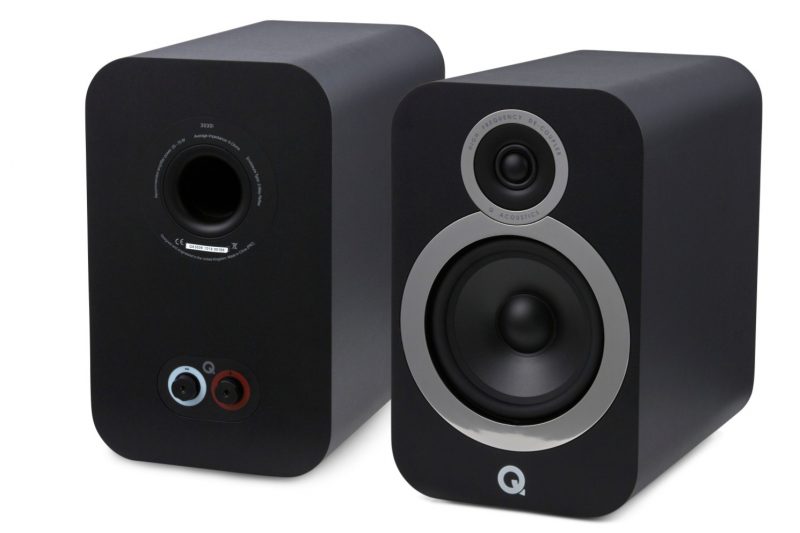Last Year when I reviewed the Q Acoustics 3020i speaker, I was amazed at their smooth, natural treble, and midrange. I thought they were almost perfect for a $300 bookshelf, bringing the “mid-rangy” British mini-monitor sound (which I love as a fan of vocal jazz) down to a much lower price point than I’ve previously seen.
Their only issue in the eyes of some is that they’re a little thin on the low end. If you play a lot of bass-heavy music, they could sound a little too “polite” when it comes to their bass dynamics.
Enter the $399 Q Acoustics 3030i Bookshelf Speaker, the new big brother of sorts to the 3020i. It’s a facsimile of the latter, except with larger dimensions (7.9 x 12.8 x 13.0 in). The rounded off box is taller and deeper this time, and they replace the 5-inch coated paper mid-bass driver with a 6.5-inch version. The idea is they will offer an enhanced low end over the smaller model.
The Q Acoustics .9-inch decoupled tweeter, which is isolated from vibrations of the larger driver, is carried over from the 3020i. Impedance is 6 ohms, and the sensitivity is 88 dB, which means you’ll get the best sound from a high-quality, high-current amp. (I recommend the Cambridge Audio CXA60 or CXA61 as good matches)

The 2-way bass reflex speaker is rear-ported, so room to breathe, especially behind it, is suggested. However, you do get foam bungs to “tune” the rear port if necessary. With the bungs in place, you can move them closer to a rear wall while reducing the speaker’s interaction with that boundary.
The cabinets make a fair amount of noise when performing the old “knock test,” but they’re nowhere near as “live” as some of the other models in this price range, like the Elac Debut 2.0’s.
Also carried over from the 3020i is the chrome finish around the drivers, magnetic grilles, and flush-mounted speaker binding posts. They also come in the same four finishes, Graphite Grey, Arctic White, English Walnut, or Carbon Black. My review units came in the matte Graphite Grey color, which I feel fits the modern design of the 3030i very well.
The 3030i’s larger cabinet and larger driver are supposed to add some more excitement on the low-end while maintaining the composure and control of the smaller 3020i. So does it? Well, let’s talk about their performance.
Disclaimer: The 3030i was sent to me by the manufacturer free of charge in exchange for an honest review.

Listening To The Q Acoustics 3030i Bookshelf Speaker
For my listening tests, I connected the 3030i to the Cambridge Audio CXA81 Integrated Amp/CXN V2 Network Streamer combo. I played music from many different genres (Rock, Jazz, Electronic, Hip-Hop, R&B) via TIDAL.
The speakers were set up about two and a half feet from the rear wall and about three feet from the side walls. My listening position was about nine feet from the speaker’s front baffles.
Just like the 3020i, the 3030i has a balanced, mid-centric, British monitor type of sound signature. If you’re interested in that type of sound, but don’t have a grand to drop on a pair of Bowers & Wilkins 606s, then you should check the Q Acoustics 3000i series out.
I love British monitors primarily because of the way they handle vocals. They have a remarkable way of conveying the emotion and phrasing of a vocalist.
This is a quality both Q Acoustics 3000i series bookshelf speakers have. While they don’t quite provide the realism you get from a pair of Harbeths, the mids are still sweet, and they draw you into the music.

However, with its larger cabinet and larger mid-bass driver, the 3030i is designed to reach down further than the 3020i, and it does.
Like I said earlier, the 3020i could be considered a little thin in the bass department, but I still liked how controlled and articulate the low end was on that model. That said, I did feel it needed a tad bit more weight at certain times.
Well, that additional weight is what you get with the 3030i. They allow you to better feel the impact of a bass drum or the zing of a bass guitar. You get the slam that you miss with the smaller 3020i.
On the other hand, with the 3030i, while there is a greater depth of bass, it’s not quite as clean as on the 3020i. The larger speaker’s bass gets a little congested when you play music with a lot of thump to it, like certain hip-hop and dance music.
But that additional punch sounds good with acoustic or jazz music. The rhythmic drive gets your head nodding. Listening to “Cantaloupe Island” by Jeff Goldblum & the Mildred Snitzer Orchestra, the drive, and dynamics provided by the 3030i’s low-end prowess entranced me. The timbre of the bass drum was spot on and propelled the track along nicely.

This song also allows you to hear the quality of the 3030i’s soundstage and imaging. While the soundstage isn’t super wide, it’s pretty deep, and the imaging is relatively focused, especially for a speaker in this price range.
I was able to hear the Piano along with the rest of the instruments in their little bubbles across the stage, and you could perceive the depth of instruments in relation to each other. Quite impressive.
Conclusion:
When playing music in their wheelhouse, which is all but the most raucous Hip-Hop and Dance music, the Q Acoustics 3030i Bookshelf Speaker is a very enjoyable and balanced listen. They readily disappear and make way for a credible presentation of a musical performance.
They are not the most accurate of speakers, their little brother the 3020i, actually bests them in that department, but I prefer the larger model’s combination of laid back, natural sound combined with their well-controlled Bass dynamics. The Imaging and midrange pull you into vocal performances like no other speaker in this price range. They fill in the low end nicely and provide a quality rhythmic drive that brings music alive. This new addition to the 3000i series clearly strengthens Q Acoustics’ position in the under $500 bookshelf game.
Where To Buy:
As an Amazon Associate, Hifitrends.com may earn from qualifying purchases via links placed throughout the site…this helps us keep the website going! Thanks in advance for your help! Prices are subject to change at any time.

I’m an audio writer who started as a young audio salesman/consumer electronics professional back in the late 90s. That’s where I discovered the magic of 2-Channel sound. My thirst for great sound has led me on a delightful music quest that continues today.



Leave a Reply